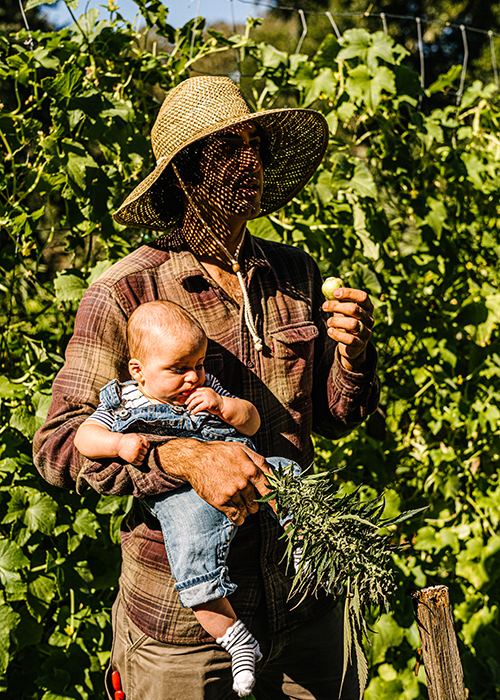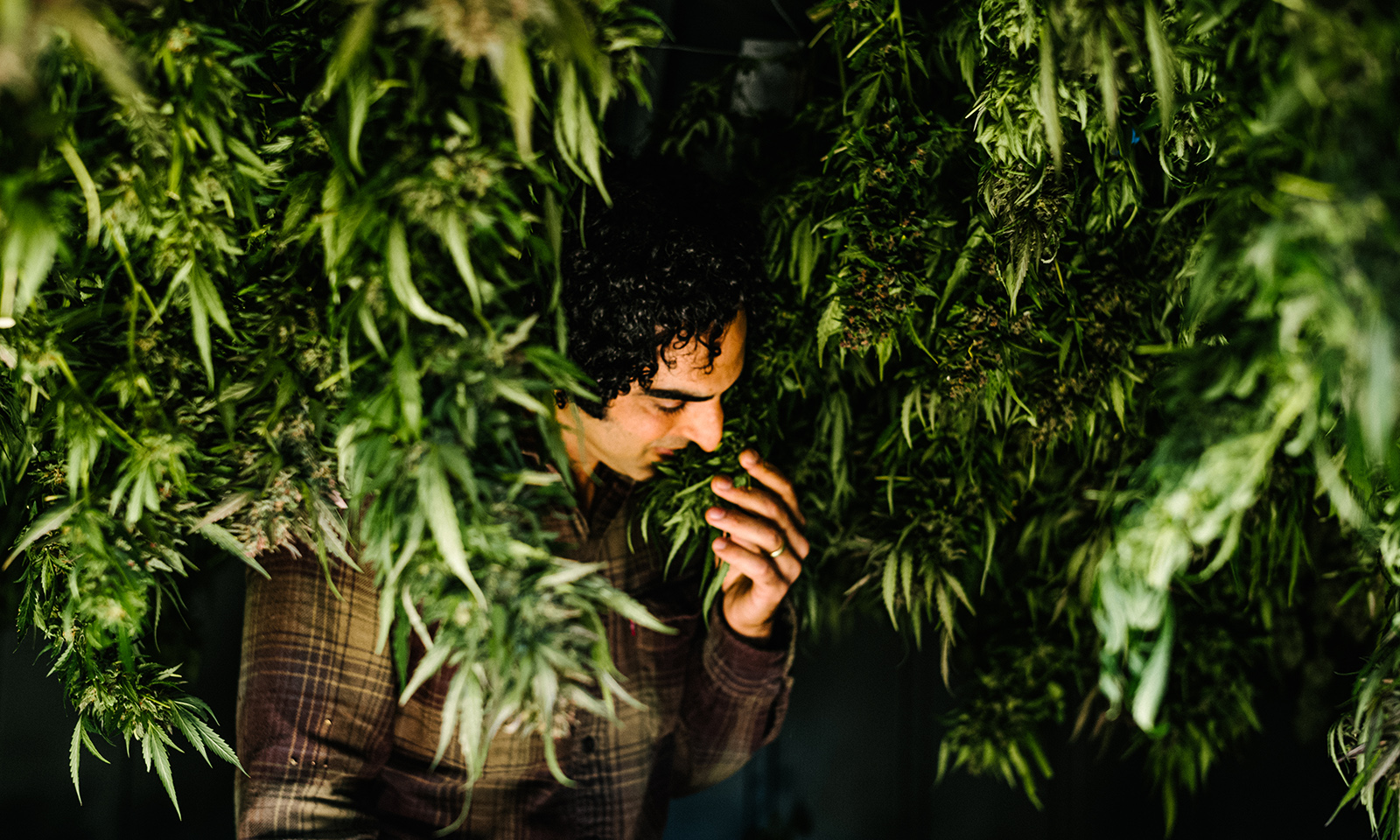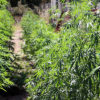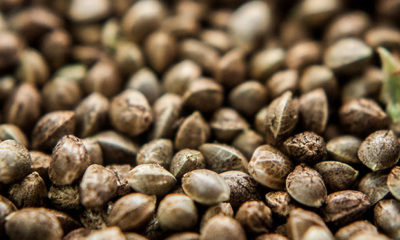The No-Till Revolution: What is No-Till Cannabis Farming?
Moon Gazer Farms grows outdoor cannabis with a regenerative method that involves preserving and improving the soil.
Josh Khankhanian walks barefoot through his Mendocino cannabis farm, pulling up pointed dark green leaves of comfrey and dropping them back on the soil. It’s the first day of October, which is an active time at any outdoor cannabis farm, but Khankhanian exudes an air of lucid calm as he decides which plants should be harvested today at Moon Gazer Farms.
Khankhanian’s walk takes him through tangled rows of beautiful cannabis in full flower, nestled around other plants, flowers and herbs. Comfrey, Jerusalem artichokes, bergamot, bog sage, holy basil, kale, fava beans, calendula and torch tithonia (also known as Mexican sunflower) all find a place among the farm’s raised soil mounds.
“Diversity is the big thing here, that’s why we have a lot of diverse kinds of plants,” Khankhanian tells me as we walk through the garden. “But even within the cannabis [on our farm], it’s as diverse as it can be. When you plant from seed, every plant is different.”

Moon Gazer Farms is the vision Khankhanian created with his wife and business partner, Sandra Khankhanian. By growing sustainable cannabis, the farm provides the pair with the means they need to live on their country homestead while raising their four-and-a-half month old twins Leo and David.
The farm’s cannabis crop comes in small batches, which can be as low as one or two pounds per strain per season or as high as 40 to 50 pounds, and every strain is grown from seed. While they do work with established genetics, Josh and Sandra also create their own strains from genetics they acquire from friends. Moon Gazer offerings include unique strains like Cherry Lemonade, an Athena Cherry Kush x Lemon Bliss cross, and Pinkle Jam, a Pinkleberry Kush x Jamaican Lions cross.
On my day in the garden, Josh and Sandra are joined by two young sisters with sunny dispositions and boundless energy who help with the children and the cannabis harvest. After I meet the crew, I duck among the rows of plants, pulling in the scent of fresh herb ready for harvest and marveling at the purple hairs on some of the buds. I pull a bunch of bergamot to make into a tea and I eat a lemon cucumber straight off the vine, taking in the clean crisp refreshment on the warm day. Later, I share a joint with the crew under the shade of a tree and the whole scene feels both idyllic and purposeful. Sandra tells me this is the place where she is supposed to be.
“We’re pot farmers,” she says. “I love weed, I smoke weed, this is what she wants me to do. You know? This is what we want to do together. This is our collaboration.”
Hügelkultur for Herb
Josh, who is originally from Los Angeles, and Sandra, who is originally from Michigan, met on a goat farm in Israel in 2010. They started their lives as farmers in California’s Mendocino County on a biodynamic vegetable farm and married in 2016, which is the same year they moved to their current property and started to grow cannabis, first as medical providers and then, following the opening of California’s recreational cannabis marketplace in 2018, for adult-use sales.
When it comes to their farming practices, Josh and Sandra pull a lot of inspiration from Jesse Dodd, the grower behind the Arcata-based cannabis project Biovortex. With Biovortex, Dodd promotes regenerative cannabis agriculture, which is defined as farming practices that rebuild soil and restore biodiversity. To spread the word, Dodd created a Regenerative Cannabis Farm Award that was first presented at the Emerald Cup, the premiere event for outdoor cannabis, in 2016.

Moon Gazer, which ended up winning the Regenerative Cannabis Farm Award in its inaugural year alongside Green Source Gardens and Dragonfly Earth Medicine, grows most of its cannabis with the hügelkultur technique, which involves creating a mound with decaying wood and filling it with compostable materials to create a rich soil.
“Hügel is basically like a lasagna layer of different things,” Josh explains. “We’ll layer some logs first, preferably oaks because they break down real nice — fungal life really likes the oaks — and then we’ll layer it with straw and material from our goat barn.”
These raised soil beds mean that Moon Gazer is a “no-till” cannabis farm, because the soil is not disturbed, instead it is built upon itself year after year. Proponents of no-till farming say that it helps protect soil from erosion, traps moisture in the soil and improves the health of soil microorganisms.
“It’s mostly just layering carbon,” Josh says. “We’re able to grow this way and be sustained because we’re growing on a small scale. To me, it’s super ideal to do this no-till system where we literally are not tilling the soil, we’re not disturbing the soil at all, we’re just layering. I like to say we’re giving back always to the earth, we’re not doing any disturbance.”
While there are still some plants planted directly into the soil at Moon Gazer Farms, most of the approximately 150 plants of about 30 different strains grown from seed are now planted in these layered beds.
“We love Hügels, we’re going to keep building Hügel,” Sandra says. “Actually somebody thought we should name one of the boys ‘Hügel’… [Hügelkultur] is about using what you have, which is what we’re all about.”
Choppin’ & Droppin’
A big part of growing cannabis in a regenerative manner involves creating a rich soil from elements sourced on the land. That means Moon Gazer often uses their other crops to support the soil that feeds their cannabis. “The comfrey is a really big aspect of our fertility program,” Josh says of the leafy shrub, which has been noted for its medicinal properties as far back as 400 BCE. “Our goal as a regenerative farm is to be as closed loop as we can be. So we’re not bringing in inputs from the store, we’re not buying liquid fertilizer. These comfrey and other plants like nettles, they’ve got tons of nice micro-nutrients and macro-nutrients too.”
Comfrey, which Josh explains can also be brewed into a tea and poured directly onto the cannabis plant’s roots, provides the soil with nutrients such as potassium, phosphorus and nitrogen. It is an excellent plant in terms of its ability to regenerate, so it’s pulled up regularly.
“We’ll go through a few times a season, we’re choppin’ and droppin’,” he says.

Function Stacking
Josh explains that under the biodynamic growing style, certain plants are great “function stackers,” meaning they fill many roles on the farm at once. For example, the Jerusalem artichoke is a root vegetable the family can eat, it has flowers to feed and attract pollinators, it provides a biomass that goes into building the soil and it can serve as food for the goats. At Moon Gazer Farms, the goats are often put to use on the cleanup crew.
On the day of my visit, Josh invites me to help with the harvest and I put on gloves and grab some trimming shears and break down a Sapphire Tsu, a strain rich in CBD. I trim off the branches by finding the natural y-shaped hooks that the sections will be hung to dry from. Then, I join others in the garden to “big leaf” the crop, or remove the large fan leaves. Once I fill a bucket with the leaves, I bring them over to the goat enclosure, where the goats are ecstatic for their mid-afternoon snack. While I watch the goats munch on fresh weed leaves, I note the silhouette of the moon against the last of the day’s light. Back in the garden, Josh is humble and says he’s growing all of this amazing outdoor herb “following the rhythm and cycles of the moon and the photoperiod of the sun.”
“Really,” he says, “what we do is we grow the soil and the plants grow themselves.”
TELL US, have you ever seen cannabis growing outdoors?
























